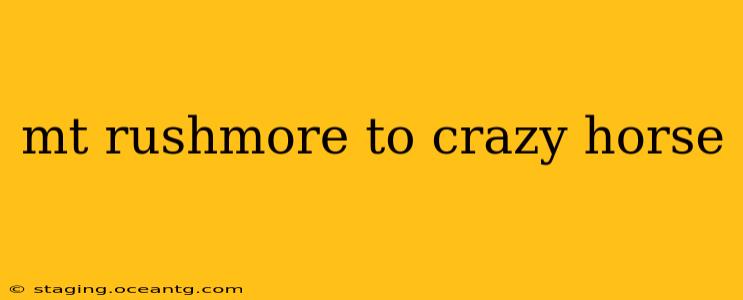Mount Rushmore and the Crazy Horse Memorial are two of America's most iconic and ambitious mountain sculptures. While both are located in the Black Hills of South Dakota and attract millions of visitors annually, their history, purpose, and artistic execution differ dramatically. This article delves into the fascinating stories behind these colossal projects, comparing and contrasting their origins, creation, and the controversies surrounding them.
What is the difference between Mount Rushmore and Crazy Horse?
The most fundamental difference lies in their subjects and the intentions behind their creation. Mount Rushmore, completed in 1941, depicts the faces of four U.S. presidents: George Washington, Thomas Jefferson, Theodore Roosevelt, and Abraham Lincoln. It was conceived as a celebration of American presidents and the nation's history, a project fueled by tourism and national pride in the era of the Great Depression. Crazy Horse, on the other hand, is a work in progress that aims to portray the Lakota warrior Crazy Horse on horseback. Initiated in 1948, it's a far more ambitious undertaking, designed to represent the Lakota people's history, culture, and spirituality. This difference in intent reflects fundamentally different perspectives on American history and national identity.
How long did it take to carve Mount Rushmore?
Mount Rushmore's construction, beginning in 1927, took 14 years to complete. This relatively shorter timeframe compared to the ongoing Crazy Horse Memorial is due to the smaller scale of the project and the use of more advanced technology and funding available at the time. The project faced numerous challenges, including the sheer scale of the undertaking and the difficult terrain, but it ultimately succeeded through dedication and government funding.
How long will it take to finish Crazy Horse?
Unlike Mount Rushmore, the Crazy Horse Memorial has no projected completion date. The sheer scale of the sculpture – planned to be far larger than Mount Rushmore – and the reliance on private donations for funding contribute to its protracted timeline. The project continues to progress slowly but steadily, driven by the Lakota people's commitment to honoring their heritage.
What is the significance of Crazy Horse Memorial?
The Crazy Horse Memorial holds immense cultural and spiritual significance for the Lakota people. It represents an attempt to reclaim their narrative and counter the often-negative portrayals of Native Americans in mainstream American history. The memorial aims to serve as a place of education and cultural preservation, fostering understanding and respect for Lakota heritage. It's more than just a sculpture; it's a living testament to Lakota resilience and pride.
How much did Mount Rushmore cost?
The total cost of Mount Rushmore, considering the time period and adjusted for inflation, represents a significant financial investment. While precise figures can be difficult to ascertain due to historical accounting practices, the project benefited from substantial federal funding and private donations. The project's funding contrasts sharply with the ongoing reliance on private donations for the Crazy Horse Memorial.
How is the Crazy Horse Memorial funded?
The Crazy Horse Memorial relies solely on private donations and admission fees, unlike Mount Rushmore, which received significant governmental support. This funding model makes the project's long-term sustainability reliant on consistent public support and private philanthropy.
Is the Crazy Horse Memorial bigger than Mount Rushmore?
While Mount Rushmore's faces are already impressive in size, the planned Crazy Horse Memorial is designed to be significantly larger, dwarfing even the colossal scale of Mount Rushmore. The sheer size of the project underscores the ambitious vision behind the memorial and its creators.
Conclusion: A Tale of Two Monuments
Mount Rushmore and the Crazy Horse Memorial stand as powerful testaments to human ambition and the enduring power of artistic expression. While both attract millions of visitors annually, their stories and the ideologies they represent offer profoundly different perspectives on American history and cultural identity. Their continued existence prompts reflection on the complexities of national narratives and the importance of understanding diverse viewpoints. The contrasting histories, funding methods, and sheer scale of these majestic monuments provide a compelling lens through which to explore the American experience.
